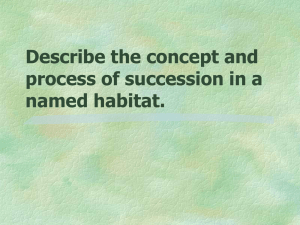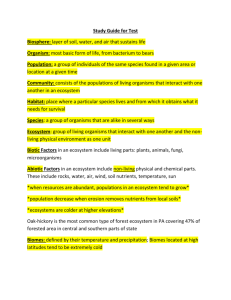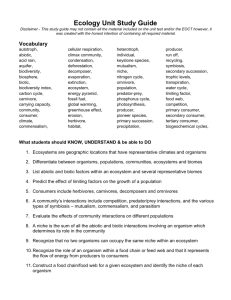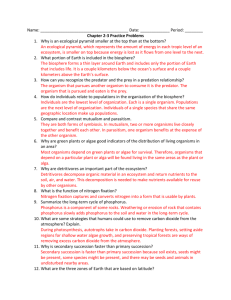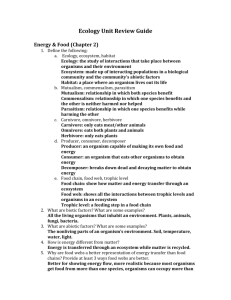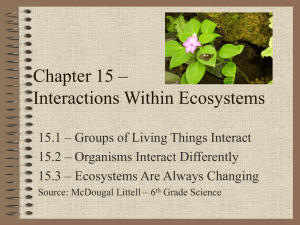Science 20 Unit D Final Test
advertisement
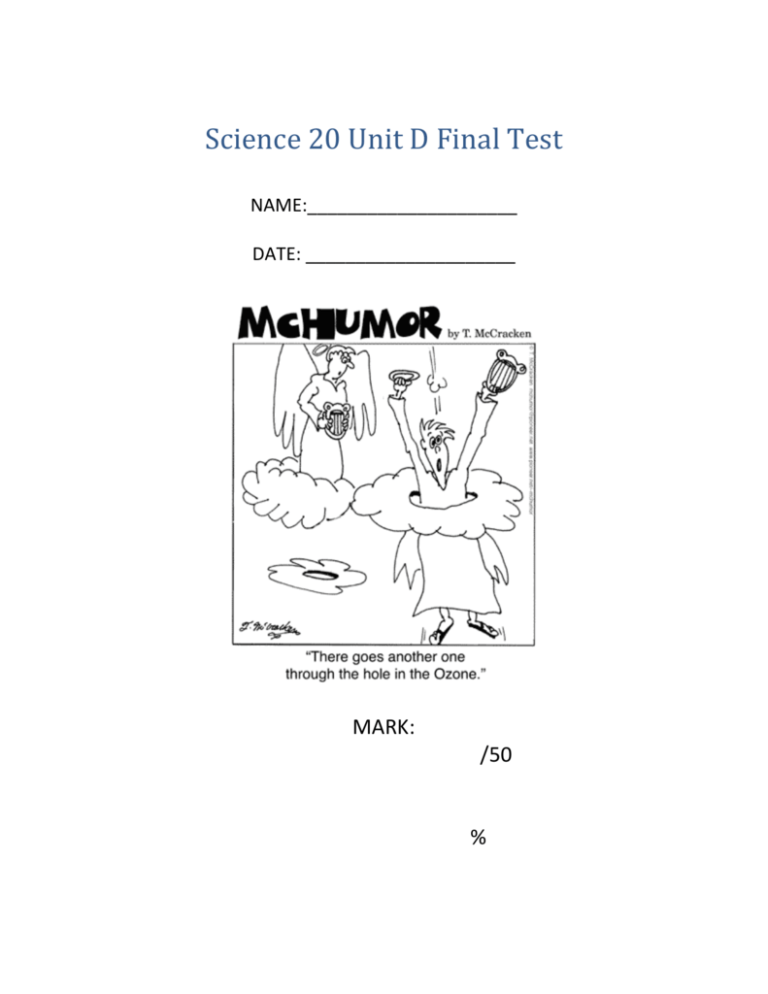
Science 20 Unit D Final Test NAME:_____________________ DATE: _____________________ MARK: /50 % GLO 1: investigate and analyze an aquatic or a terrestrial local ecosystem, distinguish between biotic and abiotic factors, describe how these factors affect population size and infer the abiotic effects on life; infer biotic interactions; infer the influence of biota on the local environment; 1. When an angler decides to fish using a particular type of fly in a shaded part of a lake or stream, she demonstrates her understanding of a. abiotic factors b. biotic factors c. stream ecosystems d. all of the above 2. The soil in a flower pot, the amount of water added to the pot, the amount of sunlight received by the plant, the amount and type of fertilizer given, and the temperature of the air surrounding the pot all make up the plant’s a. abiotic factors b. biotic factors c. ecosystem d. habitat 3. Prairie-dog burrows help to aerate the soil so the prairie grasses grow well. Bison prefer to eat this rich vegetation in and around prairie-dog towns. This relationship is an example of a. commensalism b. mutualism c. parasitism d. predation 4. A peacrab lives in the shell of a feeding mussel. The peacrab eats tiny bits of food that the mussel filters in. What is the relationship between the peacrab and the mussel? a. commensalism b. mutualism c. parasitism d. predation Use the following information to answer the next question 5. The relationship between a rabbit and a mouse living within the food web shown above is called a. predation b. symbiosis c. parasitism d. competition 6. The ecologist observes that a pond in the study area is covered with a thick layer of algae and contains few fish. The most likely cause for the conditions observed at the pond is the a. inability of sunlight to reach the pond bottom b. use of herbicides by the farm nearby c. use of fertilizers by the farm nearby d. predation of pond fish by birds GLO 2: describe the key stages of primary succession in a specific ecosystem and the nature of its climax community; GLO 3: differentiate between primary and secondary succession in a specific aquatic and a specific terrestrial ecosystem, and compare natural and artificial means to initiate secondary succession in an ecosystem, 7. The climax community for Alberta’s boreal forest is mainly coniferous trees, like spruce and pine. When these evergreens drop their needles and the dead needles decay, they cause the soil to become acidic. Coniferous seedlings grow best in acidic soils, whereas other types of plant organisms—like grasses—have difficulty growing in acidic soil. How might this strategy affect succession in the boreal forest? a. It might cause an increase in grasses b. It might cause an increase in coniferous trees c. It might cause an increase in deciduous trees d. It would have no effect Use the following information to answer the next question 8. The information above is describing a. Primary Succession b. Secondary Succession c. Tertiary Succession d. None of the above 9. Which of the following charts is correct? a. Description Primary Succession Secondary Succession relative speed of process slower faster starting conditions no soil present soil present events causing process to begin new volcanic islands from lava flow hardening, glaciers receding clearcut logging, forest fires, tilling of soil resulting community climax community climax community b. Description Primary Succession Secondary Succession relative speed of process slower faster starting conditions no soil present soil present events causing process to begin clearcut logging, forest fires, tilling of soil new volcanic islands from lava flow hardening, glaciers receding resulting community climax community climax community c. Description Primary Succession Secondary Succession relative speed of process faster slower starting conditions no soil present soil present events causing process to begin new volcanic islands from lava flow hardening, glaciers receding clearcut logging, forest fires, tilling of soil resulting community climax community climax community d. Description Primary Succession Secondary Succession relative speed of process faster slower starting conditions no soil present soil present events causing process to begin clearcut logging, forest fires, tilling of soil new volcanic islands from lava flow hardening, glaciers receding resulting community climax community climax community 10. An underwater volcano creates a new island. The type of succession that would take place is a. Primary and the climax community would be quickly established b. Secondary and the climax community would be quickly established c. Primary and the climax community would take hundreds of years to re-establish d. Secondary and the climax community would take hundreds of years to reestablish e. None of the above 11. With respect to the ecosystem’s history, the first birds that arrive at the island are considered to be i . Because the birds have the ability to interbreed, they are considered to be a ii . The statements above are completed by the information in row GLO 4: describe the potential impact of habitat destruction on an ecosystem 12. The following illustrates the sequence of events that led to a decline in the caribou population due to habitat fragmentation. I. Cleared forest areas attract moose to live in the area. II. Human activities create open areas and cutlines throughout a habitat. III. The caribou population declines due to increased predation. IV. More wolves move into the area. V. Cutlines and open areas allow wolves to spot and capture prey more easily. The order of events beginning with habitat fragmentation and resulting in a decline in the caribou population is a. I, II, III, IV, V b. V, I, II, IV, III c. II, I, V, IV, III d. II, III, I, IV, V Use the following information to answer the next question 13. Four factors listed above that could have caused the population change between1977 and 1984 shown on the graph are a. 1, 3, 4, 6 b. 1, 2, 4, 6 c. 1, 3, 4, 5 d. 1, 2, 4, 5 Use the following information to answer the next question 14. The order in which the organisms listed above appear in an ecosystem after the forest fire is _______, _______, _______, and _______. first last a. b. c. d. 1, 2, 3, and 4 3, 2, 1, and 4 2, 3, 1, and 4 1, 3, 2, and 4 GLO 5: describe the effects of introducing a new species into, or largely removing an established species from, an environment; 15. a species introduced to an area by human action that expands to threaten the area’s variety of life a. Predator b. Herbivore c. Invasive species d. Climax species 16. The elimination of one key species can affect the health of an entire ecosystem. a. True b. False Use the following graph to answer the next 2 questions 17. Which of the following are a possible reason for the trend depicted in the graph? a. Few predators b. limited food sources c. Limited shelter d. Unfavorable abiotic factors 18. Using the information in the graph above to answer the next question. Which of the following statements is correct about the graph a. It is a J curve and indicates that the species has met it carrying capacity b. It is a J curve and indicates that the population is still undergoing exponential growth c. It is a S curve and indicates that the species has met it carrying capacity d. It is a S curve and indicates that the population is still undergoing exponential growth GLO 6: outline the biogeochemical cycles of nitrogen, carbon, oxygen and water and, in general terms, describe their interconnectedness, building on knowledge of the hydrologic cycle from Science 10, Unit D Use the following information to answer the next question 19. As indicated in the diagram above, the form of nitrogen that can be directly used by plants is a. nitrite, NO2b. nitrate, NO3c. nitrogen, N2(g) d. ammonia, NH3 20. The only way that animals can receive nitrogen is through a. Breathing it in b. Eating their own wastes c. Eating plants and other animals d. Direct absorption through the skin Use the following picture to answer the next question 21. You set up the apparatus above. What is the source of energy for this apparatus, and what energy source is it trying to represent a. The water to represent water b. The clay to represent mountains c. The lamp to represent the sun d. The shoe box to represent the earth 22. Which of the following processes does not occur in the Carbon Cycle? a. cellular respiration b. pollution c. photosynthesis d. transpiration 23. In the oxygen cycle, oxygen is a. added to and removed from the atmosphere by photosynthesis b. added to the atmosphere by decomposers and removed by photosynthesis c. added to the atmosphere by cellular respiration and removed by photosynthesis d. added to the atmosphere by photosynthesis and removed by cellular respiration and combustion GLO 7: describe artificial and natural factors that affect the biogeochemical cycles: nitrogen cycle; carbon cycle; water cycle; Use the following information to answer the next question The ecologist suspects that a nearby farm may be affecting the area she is studying. Farm Activities 1 Composting plant and animal waste 2 Spraying fertilizers that contain nitrates 3 Spraying chemicals to kill insects and rodents 4 Spraying chemicals to kill soil bacteria 24. The two farm activities listed above that harm the nitrogen cycle are a. 1 and 2 b. 2 and 3 c. 3 and 4 d. 4 and 1 25. A hunter’s campfire gets out of control and burns a large section of vegetation on the island. How does fire affect the carbon cycle? a. It turns a carbon source into a carbon sink b. It turns a carbon sink into a carbon source c. It creates a carbon source d. It creates a carbon sink 26. Humans using water in industrial processes impacts the water cycle because a. The water quality improves due to filtration processes b. The water quality is reduced because we can never return the water in the same condition c. Due to processing vegetation cannot hold as much water causing an increase in the amount of water in our lakes and rivers d. Due to processing the water is more easily evaporated and creates more clouds. 27. The main impact that humans have had on the oxygen cycle is through our use of a. DEET b. CRA’s c. BRB’s d. CFC’s GLO 8: analyze and describe how energy flows in an ecosystem, using the concepts of conservation of energy (second law of thermodynamics); energy input and output through trophic levels, food webs, chains and pyramids; and specific examples of autotrophs and heterotrophs GLO 9: explain why population size and biomass are both directly related to the trophic level of the species and explain how trophic levels can be described in terms of pyramids of numbers, biomass or energy. Use the following information to answer the next two questions 28. In the ecological pyramid above, herbivores are positioned in trophic level i and producers are positioned in trophic level ii . The statement above is completed by the information in row 29. The sequence for the transfer of energy through the trophic levels indicated in the pyramid above is a. 1, 2, 3, 4 b. 2, 3, 4, 1 c. 3, 1, 4, 2 d. 4, 3, 2, 1 30. A biomass pyramid differs from a numbers pyramid because a. the two pyramids are inverted to each other b. the biomass pyramid takes into account the size and number of organisms where a numbers pyramid only reports the number c. a biomass pyramid shows the dry weight of the organisms where the numbers pyramid uses their wet weight. d. A biomass pyramid is boxy where a numbers pyramid is smooth Use the following picture to answer the next question 31. According to the pyramid above the Artic fox would only be getting this percentage of energy from the sun a. 0.001 % b. 0.01 % c. 1 % d. 10 % Using the information in the picture below answer the next question 32. Which of the following series of numbers represents a food chain starting with producers? a. 0 7 1 b. 3 1 9 c. 5 2 1 9 d. 6 3 1 0 33. Why does not all the energy pass up to the next trophic level? a. Because only water contains energy b. Because organisms need energy to live their lives c. Because organisms cannot absorb all the energy in their food d. Because only producers can capture 100% of the energy the receive GLO 10: describe mutation as the principal cause for variation of genes in species and populations GLO 11: describe the adaptation of species over time due to variation in a population, population size and environmental change; 34. Mutations can be a. Beneficial b. Harmful c. Neutral d. All of the above Use the following information to answer the next question 35. What environmental change would cause a reduction in the number of individuals born with sickle cell anemia? a. An increase in malaria b. A decrease in malaria c. An increase in the mosquito population d. None of the above 36. Which of the following events would not cause evolution of a species of birds on an island? a. Female birds randomly mate with a male rather than being selective b. A heat wave kills a lot of the insects on the island only the birds with the longest beaks can eat the rest starve c. A new baby bird is born randomly with a different colour of beak from the rest of its species d. A tropical storm comes through the island killing only the birds that make their nests in the trees, the birds that make their nests on the ground are safe 37. If the Ozone layer dissipates even more and there is more UV radiation on the surface of the Earth, what would our future generations most likely look like? a. Blonde hair and fair skin because these reflect most of the UV radiation b. Black hair and dark skin because these reflect most of the UV radiation c. Blonde hair and fair skin because these absorb the most of the UV radiation d. Black hair and dark skin because these absorb the most of the UV radiation 38. An owl is well adapted to a nocturnal hunting lifestyle. Which of the following adaptations makes the owl a more successful hunter. a. the ability to fly b. a sharp beak and talons c. huge eyes d. all of the above Use the following information to answer the next question Cold Adaptations Canada’s Arctic region is an example of a habitat where the extreme cold presents a huge survival challenge. The other big challenge is that snow melts in the short spring and summer. This means that white-coloured animals lose the advantage of camouflage. To cope with these harsh environmental obstacles, Arctic organisms have acquired several adaptations. Some organisms, such as caribou or humpback whales, only spend summers in the Arctic and migrate to warmer winter climates. Most organisms have thick layers of fat, called blubber, fur for insulation, and tiny ears to reduce heat loss. Some animals—such as the Arctic hare, Arctic fox, and a bird called a ptarmigan—are pure white in winter and brown or grey in warmer months to stay camouflaged in their changing surroundings. 39. A polar bear is an example of an organism that has adapted well to the cold Arctic. It’s a carnivore that eats primarily seals. Polar bears usually hide and wait near breathing holes in the ice to capture the seals when they come up for air. Which of the following reasons explains why polar bear is white a. To camouflage it from the seals b. To camouflage it from humans c. To allow it to absorb more heat from the sun d. To allow it to absorb less heat from the sun Use the following information to answer the next question 40. The three descriptions above that demonstrate variation of a trait within a population of organisms of the same species are a. 1, 2, 3 b. 1, 2, 4 c. 1, 3, 4 d. 1, 4, 5 41. The definition of evolution is a. A change in the gene pool over time and it is a law b. A change in the gene pool over time and it is a theory c. That all species come from one single life form and it is a law d. That all species come from one single life form and it is a theory 42. Which of the following is not a method of evolution a. mating b. mutations c. gene flow d. shrinking population GLO 12: describe evidence for evolution by natural selection; Use the following information to answer the next question. Statements 1 All populations produce more offspring than can survive. 2 Competition for resources occurs among members of a population. 3 Variation exists within a population. 4 If a trait is not used by an organism, its function is lost. 5 The strongest members of a population are best able to collect resources. 6 Organisms that live to reproduce pass their traits to their offspring. 43. Evolutionary theory can be used to explain the diversity of bird populations on the island. The statements above that are associated with the theory of natural selection are a. 1, 3, 4, and 6 b. 2, 3, 4, and 6 c. 1, 3, 5, and 6 d. 2, 3, 5, and 6 44. Natural selection means that a. Only the biggest and strongest survive b. That my genes want to be passed on to my offspring c. Those who have a better chance of mating and surviving will be selected for d. The environment can change and organism and that those traits will be passed onto its offspring there for adapting it 45. Which of the following is not support for natural selection? a. Camouflage (organisms looking like their environment in order to not be discovered by predators) b. Mimicking (organisms that look like poisonous organisms tend to be left alone like the poisonous organism that they look like) c. Homologous structures (many organisms have the same general outline for their limbs, ie bat wings, whale flippers and human hands all look similar) d. Spontaneous Generation (that organisms can develop from a combination of abiotic factors) GLO 13: compare gradual evolution with punctuated equilibrium Use the following picture to answer the next question 46. Which of the following answers correctly matches the numbers from the diagram with their proper labels? a. Change in time __2___ Gradualism __1___ Punctuated equilibrium __3___ Development of new species __5___ b. Change in time __2___ Gradualism __1___ Punctuated equilibrium __3___ Development of new species __4___ c. Change in time __2___ Gradualism __3___ Punctuated equilibrium __1___ Development of new species __5___ d. Change in time __2___ Gradualism __3___ Punctuated equilibrium __1___ Development of new species __4___ 47. A new species is created when a. They are no longer reproductively compatible b. They have a new gene not from the parent species c. They have a new chromosome not found in their parents d. They have a new characteristic not found in their parent species GLO 14: describe how factors including space, accumulation of wastes competition, technological innovations, irrigation practices and the availability of food impact the size of populations GLO 15: compare the growth pattern of the human population to that of other species. Use the following graph to answer the next question 48. A graph of the annual changes within the population of Arctic foxes is related to the graph in this question. Which of the following years would you expect the artic fox population to be at its peak? a. 1991 b. 1994 c. 1995 d. 1999 49. Which of the following graphs represents the change in the population of the birds described above over their first few years on the island? 50. a group of organisms that exists in a natural setting where births, deaths, immigration, and emigration all affect population numbers, this is known as a a. open population b. closed population c. partial population d. doubling population
